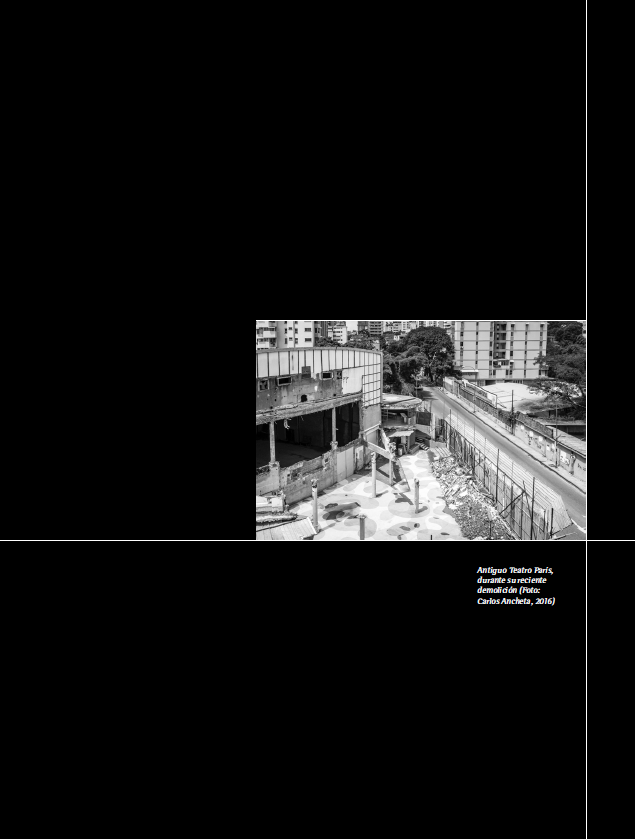Abstract
This article deals with emergence, development and decline of movie theater architecture in Caracas from 1925, when the first building specifically created for that use was erected, to 1960, year when the last of these “movie palaces” opened its doors. Over the course of these five decades, the cinema building underpinned the modernity of the growing city, attentive to the trends of its time. Since then, the cinema function has taken refuge in the interior of the large malls that have multiplied in Caracas, as a substitute of open-air public space. This process has implied the progressive closing of the old movie theaters, whose buildings have carelessly been demolished, abandoned or transformed into other uses that completely distort their architecture and their once life-giving presence in the urban fabric.
Amendola, G. (2000). La ciudad postmoderna. Madrid: Celeste Ediciones.
Barrios, G. (1992). Inventario del Olvido. Caracas: Fundación Cinemateca Nacional.
Cebollada, P. & Santa Eulalia, M. G. (2000). Madrid y el cine. Madrid: Comunidad de Madrid.
De Sola, R. (1988). Reurbanización El Silencio. Crónica. Caracas: Fundación Villanueva e Instituto Nacional de la Vivienda, INAVI.
Friedberg, A. (2006). Window Shopping. Cinema and the Post Modern. Berkeley: University of California Press.
Jacobs, J. (1961). The Death and Life of Great American Cities, New York: Random House.
Moholy-Nagy, S. (1964). Carlos Raúl Villanueva and the Architecture of Venezuela. Caracas: Lectura.
García, M. y P. Méndez. (2014). “Abstracciones de película. La arquitectura moderna de los cines argentinos, 1925-1950”, en Gazzaneo, L.M. (ed.). Artes & Territorio en el mundo lusófono e hispánico. Rio de Janeiro: Uni¬versidade Federal de Rio de Janeiro
Naylor, D. (1991). American Picture Palaces: The Architecture of Fantasy. New Jersey: Prentice Hall Editions.
Ponti, G. (1954). Coraggio del Venezuela. Domus, (295), 1-7.
Pérez Rojas, F. J. (1986). El cinematógrafo en Madrid, 1896-1960. Los cines madrileños: del barracón al rascacielos. Madrid: Museo Municipal.
Ramos, A. M. (2006). Lo Urbano en 20 autores contemporáneos. Barcelona: Ediciones UPC.
Sánchez Fernández, D. M. (1977). Cines de barrio. Madrid: Ediciones de la Librería.
Sidorkovs, N. (1994). Los cines de Caracas en el tiempo de los cines. Caracas: Armitano Editores.
Sueiro, Y. (2008) Escaramuzas cinematográ¬ficas Primeras salas de cine en Caracas, Venezuela (1896-1920). Recuperado el 12 de febrero de http://cinematv.mforos. com/296110/2290491-primeras-salas-de-cine-en-caracas-venezuela-1896-1920/
Torres, A. (ed.). (2015). Fervor de Caracas. Una antología literaria de la ciudad. Caracas: Fundavag Ediciones.
VV. AA (2009). Guía básica de arquitectura de Madrid. Madrid: COAM.
Vicente Garrido, H. (2011). La ficticia ‘ilusión’ del destierro. Arquitextos Vitrivius, 128(04).
Apuntes is registered under a Creative Commons Attribution 4.0 International Public License. Thus, this work may be reproduced, distributed, and publicly shared in digital format, as long as the names of the authors and Pontificia Universidad Javeriana are acknowledged. Others are allowed to quote, adapt, transform, auto-archive, republish, and create based on this material, for any purpose (even commercial ones), provided the authorship is duly acknowledged, a link to the original work is provided, and it is specified if changes have been made. Pontificia Universidad Javeriana does not hold the rights of published works and the authors are solely responsible for the contents of their works; they keep the moral, intellectual, privacy, and publicity rights.
Approving the intervention of the work (review, copy-editing, translation, layout) and the following outreach, are granted through an use license and not through an assignment of rights. This means the journal and Pontificia Universidad Javeriana cannot be held responsible for any ethical malpractice by the authors. As a consequence of the protection granted by the use license, the journal is not required to publish recantations or modify information already published, unless the errata stems from the editorial management process. Publishing contents in this journal does not generate royalties for contributors.



